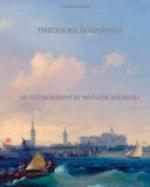I was fond of walking and climbing. As a lad I used to go to the north woods, in Maine, both in fall and winter. There I made life friends of two men, Will Dow and Bill Sewall: I canoed with them, and tramped through the woods with them, visiting the winter logging camps on snow-shoes. Afterward they were with me in the West. Will Dow is dead. Bill Sewall was collector of customs under me, on the Aroostook border. Except when hunting I never did any mountaineering save for a couple of conventional trips up the Matterhorn and the Jungfrau on one occasion when I was in Switzerland.
I never did much with the shotgun, but I practiced a good deal with the rifle. I had a rifle-range at Sagamore Hill, where I often took friends to shoot. Once or twice when I was visited by parties of released Boer prisoners, after the close of the South African War, they and I held shooting matches together. The best man with both pistol and rifle who ever shot there was Stewart Edward White. Among the many other good men was a stanch friend, Baron Speck von Sternberg, afterwards German Ambassador at Washington during my Presidency. He was a capital shot, rider, and walker, a devoted and most efficient servant of Germany, who had fought with distinction in the Franco-German War when barely more than a boy; he was the hero of the story of “the pig dog” in Archibald Forbes’s volume of reminiscences. It was he who first talked over with me the raising of a regiment of horse riflemen from among the ranchmen and cowboys of the plains. When Ambassador, the poor, gallant, tender-hearted fellow was dying of a slow and painful disease, so that he could not play with the rest of us, but the agony of his mortal illness never in the slightest degree interfered with his work. Among the other men who shot and rode and walked with me was Cecil Spring-Rice, who has just been appointed British Ambassador to the United States. He was my groomsman, my best man, when I was married—at St. George’s, Hanover Square, which made me feel as if I were living in one of Thackeray’s novels.




